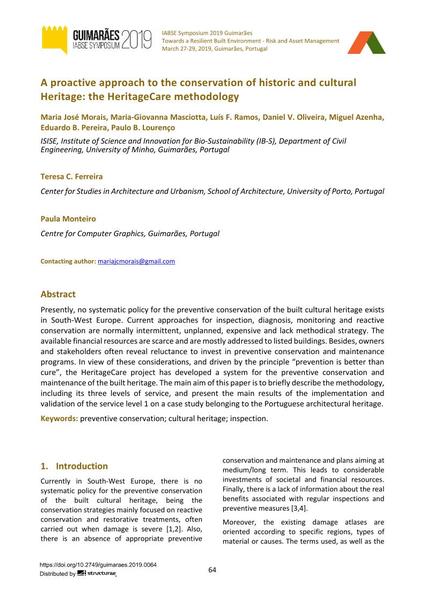A proactive approach to the conservation of historic and cultural Heritage: the HeritageCare methodology

|
|
|||||||||||
Détails bibliographiques
| Auteur(s): |
Maria José Morais
(ISISE, Institute of Science and Innovation for Bio-Sustainability (IB-S), Department of Civil Engineering, University of Minho, Guimarães, Portugal)
Maria-Giovanna Masciotta (ISISE, Institute of Science and Innovation for Bio-Sustainability (IB-S), Department of Civil Engineering, University of Minho, Guimarães, Portugal) Luís F. Ramos (ISISE, Institute of Science and Innovation for Bio-Sustainability (IB-S), Department of Civil Engineering, University of Minho, Guimarães, Portugal) Daniel V. Oliveira (ISISE, Institute of Science and Innovation for Bio-Sustainability (IB-S), Department of Civil Engineering, University of Minho, Guimarães, Portugal) Miguel Azenha (ISISE, Institute of Science and Innovation for Bio-Sustainability (IB-S), Department of Civil Engineering, University of Minho, Guimarães, Portugal) Eduardo B. Pereira (ISISE, Institute of Science and Innovation for Bio-Sustainability (IB-S), Department of Civil Engineering, University of Minho, Guimarães, Portugal) Paulo B. Lourenço Teresa C. Ferreira (Center for Studies in Architecture and Urbanism, School of Architecture, University of Porto, Portugal) Paula Monteiro (Centre for Computer Graphics, Guimarães, Portugal) |
||||
|---|---|---|---|---|---|
| Médium: | papier de conférence | ||||
| Langue(s): | anglais | ||||
| Conférence: | IABSE Symposium: Towards a Resilient Built Environment Risk and Asset Management, Guimarães, Portugal, 27-29 March 2019 | ||||
| Publié dans: | IABSE Symposium Guimarães 2019 | ||||
|
|||||
| Page(s): | 64-71 | ||||
| Nombre total de pages (du PDF): | 8 | ||||
| DOI: | 10.2749/guimaraes.2019.0064 | ||||
| Abstrait: |
Presently, no systematic policy for the preventive conservation of the built cultural heritage exists in South-West Europe. Current approaches for inspection, diagnosis, monitoring and reactive conservation are normally intermittent, unplanned, expensive and lack methodical strategy. The available financial resources are scarce and are mostly addressed to listed buildings. Besides, owners and stakeholders often reveal reluctance to invest in preventive conservation and maintenance programs. In view of these considerations, and driven by the principle “prevention is better than cure”, the HeritageCare project has developed a system for the preventive conservation and maintenance of the built heritage. The main aim of this paper is to briefly describe the methodology, including its three levels of service, and present the main results of the implementation and validation of the service level 1 on a case study belonging to the Portuguese architectural heritage. |
||||
